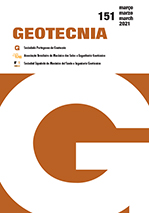Deterministic factors of safety for the evaluation of the stability of tailing dams: a reflection
DOI:
https://doi.org/10.24849/j.geot.2021.151.04Keywords:
Tailing Dams, Deterministic factors of safety and risk, Flow LiquefactionAbstract
The stability assessment of mining tailings dams has undergone an evolution in recent years, supported by the information reported by expert panels, following the numerous cases of ruptures. The management of the security levels to be adopted has been increasingly associated to the need of introducing conditioning factors for risk analysis that take into account the variabilities and uncertainties, taking into account the probabilities of the factors of stability of the dam and the implications on loss of lives and environmental impact after rupture. These characteristics of the geotechnical materials should be integrated into the distinct conditions of permanent state and the frequent and rare actions, etc. While these new methodologies are not implemented in existing structures, periodic technical safety audits are still based on deterministic Factors of Safety that seek to ensure stability of these assets. In this article, these safety factors will be discussed in the light of good international engineering practices and considerations will be made on how to ensure characteristic values of the parameters used in the stability assessment calculations and how it is considered that these analyses should be conducted under drained and undrained conditions and which equilibrium models should be used.
Downloads
References
ABNT (2017). NBR 13028 – Mineração – Elaboração e apresentação de projeto de barragens para disposição de rejeitos, contenção de sedimentos e reservação de água ― Requisitos. Associação Brasileira de Normas Técnicas, 16pg.s (ISBN 978-85-07-07286-7)
Bolton, M.D. (1986). The strength and dilatancy of sands. Géotechnique, Vol. 36, Nº 1, pp. 65 78
CDA (2019). Application of Dam Safety Guidelines to Mining Dams. Tech. Bul. Mining Dams Comm. Can. Dam Ass., https://www.cda.ca/ItemDetail?iProductID=faa3a4d0-7d70-4429-998a-f4d8dce8b588&Class=09c61659-a500-41dc-ac03-4dd71a7120b7&WebsiteKey=f82d2da7-0fd4-40d3-aa86-fb45e40121d5, Toronto, Ontario
CEN (1994). Eurocódigo 7. Projecto Geotécnico. Parte 1: Regras Gerais. EC7 - CEN ENV 1997-1. Comissão Europeia de Normalizações, Bruxelas.
Fear, C.E.; McRoberts, E.C. (1995). Reconsideration of initiation of liquefaction in sandy soils. Journal of Geotechnical Engineering, ASCE,121(3): 249–261
Gens, A. (2019). Hydraulic fills with special focus on liquefaction. Proc. XVII ECSMGE-2019. Geotech. Engin. Foundation of the future. doi: 10.32075/17ECSMGE-2019-1108
ISO (2018). Risk management. Guidelines. ISO 31000:2018 2nd edit., Feb.2018. 16 pp.
Jefferies, M.; Morgenstern, N. R.; Van Zyl, D, Wates, J. (2019). Report on NTSF Embankment Failure. Cadia Valley Operations for Ashurst Australia. Independent Technical Review Board. : http://www.newcrest.com.au/investors/market-releases
Kayen, R.E.; Mitchell, J.K.; Lodge, A.; Seed, R.B.; Nishio, S.; Coutinho, R. (1992). Evaluation of SPT-, CPT-, and shear wave-based methods for liquefaction potential assessment using Loma Prieta data. In Proceedings of the 4th Japan–U.S. Workshop on Earthquake Resistant Design of Lifeline Facilities and Countermeasures for Soil Liquefaction. Edited by M. Hamada and T.D. O’Rourke. Technical Report NCEER-94-0019, Vol. 1, pp. 177–204.
Matos Fernandes. M. (2000). Eurocódigo 7: Questões essenciais e ponto da situação, Atas do 7º Congresso Nacional de Geotecnia. FEUP, Porto. Ed. SPG.
MPEMG (2020). Procedimento Investigatório Criminal n.ºMPMG-0090.19.000013-4. Inquérito Policial n. PCMG-7977979
Nova, R. (1994). Controllability of the incremental response of soil specimens subjected to arbitrary loading programmes. Journal of the Mechanical Behavior of Materials, 5(2), 193–201. https://doi.org/10.1515/JMBM.1994.5.2.193
Olson, S.M.; Stark, T.D. (2003). Yield Strength Ratio and Liquefaction Analysis of Slopes and Embankments. J. Geotech and Geoenviron. Eng., 129 (8), 727-737
Reid, D.; Fourie, A.; Ayala, J. L.; Dickinson, S.; Ochoa-Cornejo, F.; Fanni, R.; Garfias, J.; Viana da Fonseca, A.; Ghafghazi, M.; Ovalle, C.; Riemer, M.; Rismanchian, A.; Olivera, R.; Suazo, G. (2020). Results of a critical state line testing round robin programme. Géotechnique 0 0:0, 1-49, https://doi.org/10.1680/jgeot.19.P.373
Rêmy. J. P. P. (2016). Lições aprendidas com o monitoramento do desempenho e com a avaliação da segurança de barragens. Conferência no Clube de Engenharia no Rio de Janeiro, apoio do CBDB - Núcleo Rio, ABMS - Núcleo Rio) e ABGE - Núcleo Rio.
Robertson, P. (2016). Cone penetration test (CPT)-based soil behaviour type (SBT) classification system — an update. Canadian Geotechnical Journal 53:1910-1927, https://doi.org/10.1139/cgj-2016-0044
Robertson. P. K.; de Melo, L.; Williams, D. J.; Ward Wilson (2019). Report of the Expert Panel on the Technical Causes of the Failure of Feijão Dam I. December 12, 2019 http://www.b1technicalinvestigation.com/
Santos Junior, M. P.; Silva Ribeiro, S. G. (2018). Uso da distribuição Log-Normal de três parâmetros da razão de resistência não drenada de pico em análise probabilística de liquefação estática em barragens de rejeito. COBRAMSEG 2018 “Geotecnia e Desenvolvimento Urbano” -, Salvador, Bahia, Brasil ©ABMS.
Soares, M.; Viana da Fonseca, A. (2016). Factors Affecting Steady State Locus in Triaxial Tests. ASTM Geotech Testing J. Vol. 39, No. 6, pp. 1056-1078
Taguchi, G. (2014). Fault tree analysis of slurry and dewatered tailings management. Dissertação de Mestrado, The University of British Columbia, Vancouver.
Viana da Fonseca, A. (2007). Relato da experiência Portuguesa em ensaios de carga em estacas. Parte I: acções verticais. Revista Geotecnia, nº especial (111), pp. 5-57
Viana da Fonseca, A. (2012). Application of in situ testing in tailing dams, emphasis on liquefaction: case-history. Workshop on Practical Applications ISC’4 (www.isc-4.com/). “Geotechnical and Geophysical Site Characterization 4”, A. Balkema, CRC, Taylor & Francis Group, London, UK. Vol. 1, pp. 181-203




